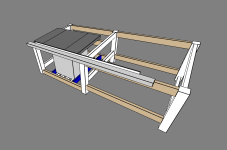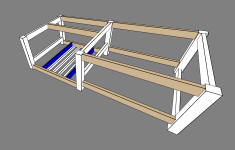ericsink
Member
- Joined
- Jan 14, 2025
- Messages
- 1
I’m planning a table with an apron attached at the top of the legs with dominos, so I’m bumping into the somewhat classic questions about intersecting mortises.
A few specifics about the context: I intend to make the table legs 3.5 inches thick (call that 89 mm), and the apron 1.5 inches thick (38 mm). The vertical size of the apron (the “width” of its boards) is currently planned at 4 inches (102 mm). Any of these dimensions could change if I have a reason.
Strength is an issue. This “table” is planned at 4 ft by 8 ft, and is actually a new home for my 3HP cabinet saw. Between the saw and all its accessories and storage, there could be maaaaaybe 1,000 pounds of “payload”. If it looks like I’m overbuilding this, that’s intentional.
I’m thinking 14 mm dominos. The rule of thirds would say 38/3=12.667 mm, and in this kind of situation, I round up.
For the length: It’s common to see folks recommend a depth between 1/2 and 2/3 of the width of the leg. Using that guideline, assuming the four vertical sides of the leg are the same width, if the apron is centered on that width, the mortises will intersect.
So I would lean toward 14x100 dominos to get a 50mm mortise into the 89 mm leg.
(1) The last time I faced a similar problem in my pre-Festool life, I mitered the tenons. That situation was “regular” tenons on the apron boards, not loose tenons, but still, similar. Anyway, I could do that with the dominos, but I’m kinda looking for a good way not to.
I saw one person mention (2) another way to deal with intersecting mortises: Cut one mortise, glue in the tenon, wait for it to dry, then cut the other mortise, thus cutting into the first domino. Interesting, I suppose.
So what’s the best way to have the mortises NOT intersect?
(3) Make the mortises shallower. If my geometry is correct, the intersection is around 37.5 mm. Call it 35, and the tenon would need to be a bit shorter than that. So I would probably be giving up some joint strength. I also note that I would be cutting tenons to custom lengths unless I go all the way down to a 10x50.
(4) Offset the apron toward the outside of the leg. If the mortises are 50mm deep, one mortise won’t crash into its sibling mortise if that sibling is offset more than 50mm from the shared edge of the leg. This is tricky to explain without a picture, so hopefully that makes sense. The mortises can’t intersect if they can’t reach each other. But again, the joint would probably be stronger if the apron is centered, right?
In this example, there would 50mm on one side of the mortise and 89-14-50=25mm on the other side. That might be okay.
(5) Put the two mortises at different positions vertically. Suppose I do go with 102mm for the apron boards, and suppose I do just one 14x100 domino, which is apparently 27.9mm wide. There’s plenty of room to have those two tenons avoid each other by putting them at different heights. But of course, all else equal, if I have room for two dominos, I would rather have two. Maybe I could make the apron boards even wider so I would have room for two on each side but still have them avoid each other? Intuitively, if that were true, there would be room for three.
Is there an option I’ve missed?
Which option would you choose?
A few specifics about the context: I intend to make the table legs 3.5 inches thick (call that 89 mm), and the apron 1.5 inches thick (38 mm). The vertical size of the apron (the “width” of its boards) is currently planned at 4 inches (102 mm). Any of these dimensions could change if I have a reason.
Strength is an issue. This “table” is planned at 4 ft by 8 ft, and is actually a new home for my 3HP cabinet saw. Between the saw and all its accessories and storage, there could be maaaaaybe 1,000 pounds of “payload”. If it looks like I’m overbuilding this, that’s intentional.
I’m thinking 14 mm dominos. The rule of thirds would say 38/3=12.667 mm, and in this kind of situation, I round up.
For the length: It’s common to see folks recommend a depth between 1/2 and 2/3 of the width of the leg. Using that guideline, assuming the four vertical sides of the leg are the same width, if the apron is centered on that width, the mortises will intersect.
So I would lean toward 14x100 dominos to get a 50mm mortise into the 89 mm leg.
(1) The last time I faced a similar problem in my pre-Festool life, I mitered the tenons. That situation was “regular” tenons on the apron boards, not loose tenons, but still, similar. Anyway, I could do that with the dominos, but I’m kinda looking for a good way not to.
I saw one person mention (2) another way to deal with intersecting mortises: Cut one mortise, glue in the tenon, wait for it to dry, then cut the other mortise, thus cutting into the first domino. Interesting, I suppose.
So what’s the best way to have the mortises NOT intersect?
(3) Make the mortises shallower. If my geometry is correct, the intersection is around 37.5 mm. Call it 35, and the tenon would need to be a bit shorter than that. So I would probably be giving up some joint strength. I also note that I would be cutting tenons to custom lengths unless I go all the way down to a 10x50.
(4) Offset the apron toward the outside of the leg. If the mortises are 50mm deep, one mortise won’t crash into its sibling mortise if that sibling is offset more than 50mm from the shared edge of the leg. This is tricky to explain without a picture, so hopefully that makes sense. The mortises can’t intersect if they can’t reach each other. But again, the joint would probably be stronger if the apron is centered, right?
In this example, there would 50mm on one side of the mortise and 89-14-50=25mm on the other side. That might be okay.
(5) Put the two mortises at different positions vertically. Suppose I do go with 102mm for the apron boards, and suppose I do just one 14x100 domino, which is apparently 27.9mm wide. There’s plenty of room to have those two tenons avoid each other by putting them at different heights. But of course, all else equal, if I have room for two dominos, I would rather have two. Maybe I could make the apron boards even wider so I would have room for two on each side but still have them avoid each other? Intuitively, if that were true, there would be room for three.
Is there an option I’ve missed?
Which option would you choose?


